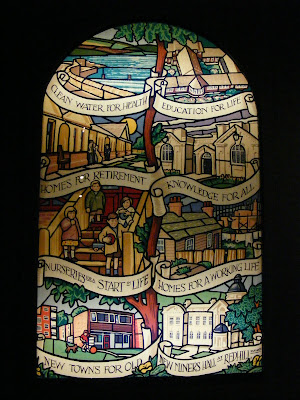Glass is a big deal in Sunderland, so of course they had a sizeable display in the museum. There was a fair bit of explanatory text, but as usual I've learned much more here at home on the internet. That learning is one of the principle things that makes blog writing enjoyable, I think.

I thought the 'Friggers' sign referred to a specific glass maker, but I was mistaken.

In fact, that is a term that refers to unusual items made from glass, like walking canes, bells, paperweights or rolling pins.

Wikipedia says the term refers to trial or test pieces made in a factory, but most glass collector sites talk about the whimsical pieces.
Joblings was a glass making factory - 'glassworks' in Sunderland, famous for several reasons and fascinating to me for all of them. To start with, they partnered with the American company, Corning, in 1921 to make Pyrex dishes. The link explains the historical significance of Pyrex in Britain.
I still have and use three blue and white patterned Corningware dishes that Mom owned, complete with lids and detachable handles. I don't think they make this kind anymore, as you can use these in the freezer, the oven, the microwave (which came along after Corningware of course) and on the stove top. We put one in the motorhome to use because it was the most versatile and would earn its space. The one thing it doesn't have is a non-stick surface; however a soak in vinegar or bleach takes care of most problems without much work.

The other thing was that in the 1930s Jobling made pressed glass along the lines of Lalique designs:

Art Deco Art Glass, which of course I think is beautiful. I could see me collecting some of these items...as soon as I get rid of some of the stuff I already own.

The funny thing is that in looking up information about these items, I found these bowls for sale.

The are the exact same bowls I bought in Manchester - six for £6!

We eat our fruit dessert out of these things every night. I'm thinking I need to go back to Manchester and look around some more!
There was also a lot of information about etched and engraved glass, particularly about the collection of glassware referred to as the Londonderry table service.
 |
| This service was used for the last course of the meal and, placed on a shiny table, it glittered beautifully in the candlelight. We really should have more meals by candlelight... |
The other service is called 'Lambton bowls' and for the life of me I cannot find it on the internet - I'm not interested in bowling, not even on a green!

Never mind, they are part of a set made in 1823 for John George Lambton, later the first Earl of Durham. (NB: the current Earl of Durham's wikipedia page and the links there make for rather interesting reading. Actually, that of his father is even better: see 'gardening and debauchery'.) I'd not realised there was a Lambton castle, but I've long heard about the Lambton Worm, a local legend (you'll see what I mean about the Sunderland accent...).

Finally, in another part of the museum describing the work and living conditions of miners, I snapped a photo of this stained glass window. Clean water, education, decent housing, a home for retirement (as many houses were supplied as part of one's work), a community centre, child care, were all aspirations of the working class. I was thinking how much of this is readily accessible to most of us and how we take it all entirely for granted. And now, having found links to all those castles, how great the divide between the aristocracy and the working people.



1 comment:
Thanks for your recent comments on my blog...I'm going to post a wedding soup recipe tonight or tomorrow when I have time to tweak the post. It's been sitting as a draft for two weeks now!
If I were going to collect anything (which I don't because of space), I would collect glass. Although I know very little about what is "collectable" and what isn't, I love to see glass displayed in a sunny room. I have a few pieces in my kitchen, and I treasure them (and use them, of course).
The Zwaanendael Museum I posted about has a large collection of painted glass in various colors, and the display was beautiful. Truthfully, though, I have no idea of the connection to the history of our state...it was a bit strange, but beautiful!
Corning...the cornflower blue...wow, that takes me back. It's good stuff, and all over the "flea markets" now. I have just a few pieces still; I should store them where they are more accessible and use them more.
Post a Comment